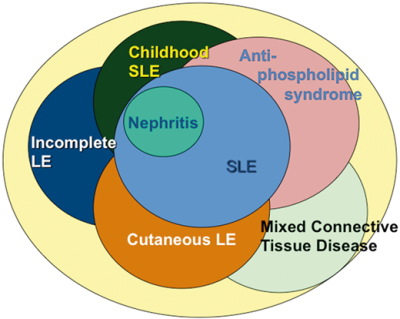Systemic Lupus Erythematosus (SLE)
- multifactorial autoimmune disease that mostly affects young women
SLE is part of a spectrum
- SLE is one component of the lupus spectrum
- Adult or paediatric patients with nephritis also have SLE, but other lupus syndromes incompletely overlap with SLE itself.
- Incomplete lupus and cutaneous LE may be subsets that include individuals who will eventually develop SLE.
- Cutaneous lesions occur in up to 85% of patients with SLE and are the first sign in up to 28%
- MCTD has distinct elements outside of the usual lupus spectrum, such as erosive arthritis.
- Anti-phospholipid syndrome may exist as a separate entity or may be part of SLE
Clinical
- Triggers for flares include the following:
- infections, ultraviolet irradiation,
- medications such as quinidine, hydralazine and procainamide
- pregnancy
- Premature atherosclerosis is an important cause of morbidity and mortality in SLE
- Metabolic syndrome - a clustering of cardiovascular risk factors associated with insulin resistance and an increased risk of future type 2 diabetes mellitus and cardiovascular disease
- Adult SLE patients are at risk of glucocorticoid-induced osteoporosis
- Lupus enteritis, including GI vasculitis, is common with or without infarction
- prevalence of intestinal vasculitis variously reported up to 53%
Management
- antimalarials - in particular hydroxychloroquine
- pulse therapy with steroids occasionally - often used but evidence is lacking for high dose therapy
- immuno-suppressants - azathioprine does have steroid sparing effects, cyclophosphamide, Mycophenolate mofetil
- biologics - Rituximab, Belimumab, Silfalimumab
References include
abdo pain in lupus
review of diagnosis and Mx 2016
